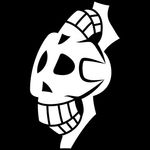- Home
- Photoshop ecosystem
- Discussions
- How to achieve a single-color "halftone" pattern?
- How to achieve a single-color "halftone" pattern?
Copy link to clipboard
Copied
How to achieve this halftone texture like in the photo? I mean, how do you make a halftone pattern without it being made up of multiple CMYK colors? This is exactly what was done in this photo 🤷:female_sign:
(Applying a halftone texture doesn't solve the problem because the image is not converted to dots.)
 1 Correct answer
1 Correct answer
When I use the default halftone filter, it consists of dots of all three colors in any area of the photo.
But in this photo, the pattern does not consist of dots of all three colors in any area of the image:
By @Donald J. Duck
Use this filter in Luminocity mode (or apply it to a copy of the layer that is in Luminocity mode).
Explore related tutorials & articles
Copy link to clipboard
Copied
Not sure I understand what you mean.
Have you tried both default Halftone Filters (as Smart Filters naturally)?
What are your output-needs? RGB or actual CMYK?
A work-around with Pattern Layers set to Blend Mode Hard Mix seems possible.
Edit:
Copy link to clipboard
Copied
When I use the default halftone filter, it consists of dots of all three colors in any area of the photo.
But in this photo, the pattern does not consist of dots of all three colors in any area of the image:
Copy link to clipboard
Copied
You could try Hard Mix Pattern Layers.
Copy link to clipboard
Copied
When I use the default halftone filter, it consists of dots of all three colors in any area of the photo.
But in this photo, the pattern does not consist of dots of all three colors in any area of the image:
By @Donald J. Duck
Use this filter in Luminocity mode (or apply it to a copy of the layer that is in Luminocity mode).
Copy link to clipboard
Copied
(or apply it to a copy of the layer that is in Luminocity mode).
By @r-bin
I agree, this looks like a luminosity blend of a CMYK halftone rosette pattern (not a single colour halftone stipple), over a standard contone image, not a conversion of a standard image directly to a halftone. One should also consider doing this in CMYK mode so that the halftone pattern is based on 4 channels, not 3. It can always be converted back to RGB afterwards.
Copy link to clipboard
Copied
Copy link to clipboard
Copied
@Donald J. Duck – that's a strange pattern, not what I would expect from the original examples.
Copy link to clipboard
Copied
Indeed, the halftone pattern here does not look the same as on the computer. Perhaps because I forgot to convert the image to RGB
Copy link to clipboard
Copied
What were the exact steps taken?
Copy link to clipboard
Copied
image > mode > cmyk > filter > pixelate > color halftone (105, 75, 90, 45)
then changed the blending mode of the halftone pattern smart filter to Luminosity
Copy link to clipboard
Copied
Was the filter applied in RGB or CMYK mode?
Did you fade or blend at reduced opacity?
There is a more convoluted way to create better halftones, but it all depends on your requirements.
Copy link to clipboard
Copied
Was the filter applied in RGB or CMYK mode?
CMYK
Did you fade or blend at reduced opacity?
Yes, I reduced the opacity of the pattern by 90%.
There is a more convoluted way to create better halftones, but it all depends on your requirements.
This is interesting. Where can I read about this way?
Copy link to clipboard
Copied
Yes, I reduced the opacity of the pattern by 90%.
So the layer is only at 10% opacity? That is very low, I used 30% in my example.
This is interesting. Where can I read about this way?
By @Donald J. Duck
Bitmap mode is explained here:
https://helpx.adobe.com/au/photoshop/using/converting-color-modes.html
https://helpx.adobe.com/au/photoshop/using/color-modes.html
I have attached a layered PSD comparing the Color Halftone filter vs. Bitmap Mode conversion methods.
Copy link to clipboard
Copied
So the layer is only at 10% opacity? That is very low, I used 30% in my example.
As you increase the transparency of the halftone smart filter, the image stops looking like it's made up of halftone dots and starts looking like it's been layered with a regular texture.
Bitmap mode is explained here:
https://helpx.adobe.com/au/photoshop/using/converting-color-modes.html
https://helpx.adobe.com/au/photoshop/using/color-modes.html
I have attached a layered PSD comparing the Color Halftone filter vs. Bitmap Mode conversion methods.
Thanks a lot for the sources!
Copy link to clipboard
Copied
You can also apply the filter to just one channel. Be advised that your mileage may vary and all that.
Copy link to clipboard
Copied
How is this done?
Copy link to clipboard
Copied
I'm nopt seeing any halftone texture in your example images.
So long as your background colour iis white, you'll only have the foreground colour after using Sketch > Halftone.
If you use Image > Adjustments > Curves with a Smart Object, you can control the tonal range of the image making the Halftone texture visible across the entire image. I just lifted the blacks to about 60 which gave me a trace of Halftone on the black jumper.
Copy link to clipboard
Copied
It looks to me like these are printed pieces, scanned at high enough resolution to show the rosettes, but not high enough to resolve the individual dots.
Copy link to clipboard
Copied
Yes, I allowed for this option. It seems true.
Copy link to clipboard
Copied
Find more inspiration, events, and resources on the new Adobe Community
Explore Now







